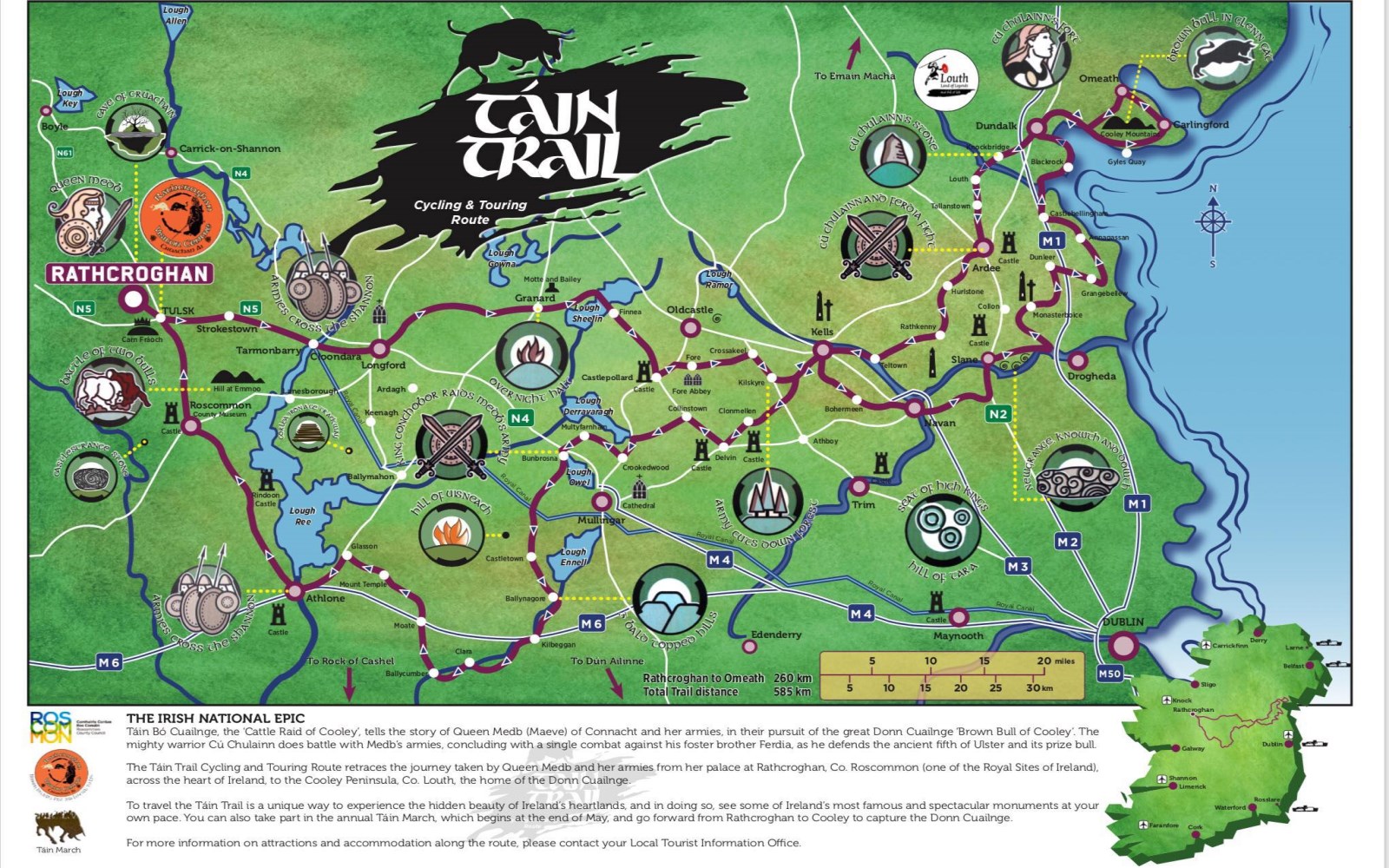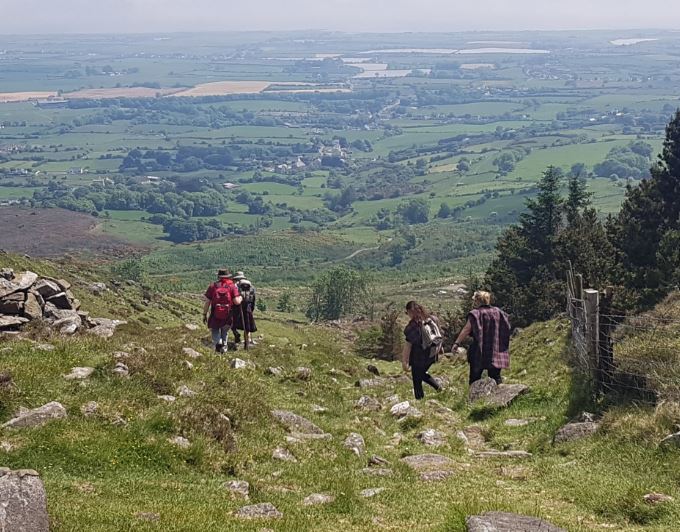The Táin Trail

*Download/print map here*
Measuring some 315 miles (504 kilometers), the trail brings you to the legendary places of the Táin - but also embraces sights, some famous, some little known for their history or beauty or both. Following the Táin Trail reveals the treasure House of the hidden Ireland: a more peaceful land than in the times of the battles of old but every bit as exciting.
The Táin Bó Cuailgne, the cattle raid of Cooley is the most famous of Irish sagas. Perhaps as much as 2,000 years old, it is also one of the most ancient in northern Europe. In this ancient saga Queen Maeve of Connaght and her husband Ailill decide one night to compare their possessions. After much discussion it becomes evident that Ailill owns a great white bull, Finnbennach, which Maeve has no equal for. There is only one bull in Ireland the equal of Finnbennach, the great Brown Bull of Cooley. Maeve decides she must have the Brown Bull and so begins the story of the Táin Bó Cuailgne.
The Táin Trail driving and cycling route is some 500 kilometres in length and follows the route taken by the armies of Ireland in the ancient saga Táin Bó Cuailgne, the cattle raid of Cooley. The trail takes in many famous monuments and attractions from the fantastic World Heritage sites of Newgrange and Knowth, exquisite sculptures Celtic crosses of the early Christian Church, medieval castles, monasteries and the great houses of the 18th century. On the other hand there are the comforts of the vibrant Ireland with excellent accommodation and food to suit everyone and of course traditional and modern pubs and plenty of the “craic”. Above all is the fact that the Táin brings its followers to the hidden Ireland, over mountains, by the seaside, to lakes and noble rivers, where life moves at a leisurely pace and the pass is ever present.

The Story of the Táin
The armies of Maeve set forth from the Royal Palace at Rathcroghan, in county Roscommon and crossed into Longford at the Shannon fords at Tarmonbarry. Between here and Longford town was Trego, the plain of the sphears, where the armies were attacked by the Celtic war-spirit, Nemain. After an overnight halt at Granard today advanced towards Crossakeel in County Meath, the scene of Cúchulainn’s first threat to the armies.
At Kilskeer the armies cut down a great forest before the chariots, and then stopped for the night in Kells. It is here that Cúchulainn read the tracks of the armies to gauge their numbers, which he estimated 18 troops and 3000 each. From Kells the route pass through Navan and Slane and close to the river Mattock, scene of the first bloody encounter between their armies and Cúchulainn and where they hear of his “Boyhood Deeds”. The armies passed on through the “Pig Keepers Plain” north of Drogheda and close to Monasteboice (Monastic Site) to reach the “Broad Ford” or Dundalk Bay, where many chariots were shattered in fierce fighting.
The armies then advanced on Cooley where the main part of the story takes place. They laid waste to the countryside in their search for the Brown Bull who was hidden in “The Black Cauldron” in the valley of Glenn Gat in the Cooley Mountains. They tore up the “Cattle Gap” or “Windy Gap” as a mark of dishonour to Ulster, but eventually captured the bull and met at Faughart where Cúchulainn was attached by the war-goddess Morrigan. This is the most challenging and spectacular part of the route, as it runs through the “Windy Gap”, and along mountain roads down to Omeath, with the Mourne Mountains rising above Carlingford Lough in the distance. The lie of the land is very much the same as it was when Queen Maeve came through the Windy Gap in her pursuit of the Brown Bull.
The armies passed back along the road to Dundalk, the site of Cúchulainn’s own fort, Dún Dealgan, and on to Ardee through Knockbridge, where badly wounded Cúchulainn slept for three days and three nights before his ferocious attack on Maeve's forces. In the later tale of his death, the Cloghafarmore (Big Man's Stone) just outside Knockbridge is said to be the pillar-stone Cúchulainn strapped himself to, as he was dying.
Ardee (Ferdia’s Ford) is the scene of the last and greatest single-combat of the Táin, when Cúchulainn fights and kills his own foster brother Ferdia. Two modern sculptures on the banks of the River Dee now commemorate their fight.
As Maeves armies began to retreat westward again, the Ulster warriors were finally woken from their sleeping spell and hastened to assist Cúchulainn. Teltown (Tailtui), near Navan, was the scene of the terrible battle of the charioteers and was one of the three great gathering places of ancient Ireland.

At “Warriors Ford”, on the Brosna River near Mullingar, King Conchobar of Ulster made a raid on the retreating armies and brought back eight score heads. The Ulster armies assembled outside Mullingar for the final great battle. Fergus vented his fury on the “Three bald topped hills” which he levelled with three strokes. The bloody battle finally ends here and Cúchulainn watches Maeve’s armies cross back over the Shannon at Athlone, into their own province.
The two bulls eventually meet and begin their own battle at the Hill of Emmoo, north-east of Roscommon Town. They fight, circling the whole of Ireland, with the Brown Bull emerging victorious, but mortally wounded. He makes his final journey back across Ireland to his home in Cooley, with the remains of the white bull hanging from his horns, and so ends this epic tale.




